John Sulman
Sir John Sulman (29 August 1849 – 18 August 1934) was an Australian architect. Born in Greenwich, England, he emigrated to Sydney in 1885. From 1921 to 1924 he was chairman of the Federal Capital Advisory Committee and influenced the development of Canberra.
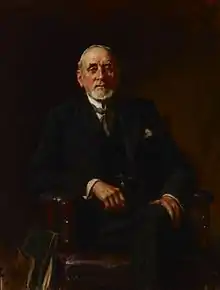
Early life
.jpg.webp)
Born in Greenwich, England, Sulman was educated at the Greenwich Proprietary School and in 1863 passed the Oxford junior examination. After his family moved to Croydon next year, he was articled to Thomas Allom, a London architect. He learned the use of oils and watercolour, and executed perspective drawings for Sir George Gilbert Scott.
Following illness, Sulman resumed work in London in 1868. While articled to H. R. Newton, he attended classes at the Architectural Association and at the Royal Academy of Arts, winning the Pugin travelling scholarship in 1871. After travelling through England and Western Europe Sulman began practising as an architect in London and designed among other buildings a large number of churches, including one of his best known Highbury Congregational Church. An associate of the Royal Institute of British Architects in 1872 (fellow, 1883), Sulman designed the Congregational Church(now the United Reformed Church) at Caterham, Surrey, where he was the son-in-law of one of the deacons. The first wedding there was his own, to Sarah Clark Redgate (d. 1888) on 15 April 1875, after which the couple moved to Bromley, Kent where he lectured on applied art and formed the Nineteenth Century Art Society. John and Sarah had three children, a son Arthur (1882–1971) and daughters Florence E. (1876–1965) and Edith (1877–1907). They moved to Sydney, Australia on account of Sarah's tuberculosis. They arrived on 13 August 1885 and settled at Parramatta, but Sarah survived little more than three years and died on 31 December 1888.
Career in Australia
In Sydney Sulman briefly formed a partnership with C. H. E. Blackmann from 1886–1888, then from 1889 formed the practice Sulman & Power with Joseph Porter Power.[1] The partnership designed many notable buildings in Sydney, country NSW, and in other capital cities, including large office buildings, churches, colleges, hospitals, and houses for prominent people. His residential and college designs of the late 1880s shows early influence of the Queen Anne or Arts & Crafts (later known as Federation), while his commercial designs were Palladian or Baroque, and his churches Gothic or Romanesque. Many of the larger city buildings have been demolished. Notable designs included the Italianate/Federation style Thomas Walker Convalescent Hospital, Concord, Sydney (1892),[2] the Palladian style A.M.P. buildings in Brisbane (1886) and the Edwardian Baroque style Melbourne example (1906) (both demolished), the grand Baroque style (Colonial) Mutual Life Association building, Sydney (1889, demolished), The Armidale School in northern NSW (1893) in an inventive Federation style, the Romanesque Sargood warehouse (now Ross House), Melbourne (1899) and several suburban churches such as the Romanesque St Andrew's Manly (1890). Between 1887 and 1912 Sulman was P. N. Russell lecturer in architecture at the University of Sydney. After 1908 he retired from active practice to some extent to develop his interest in town-planning. From 1916 to 1927 he was the Vernon lecturer in town planning at the University of Sydney. In 1921 he published his An Introduction to the Study of Town Planning in Australia.
Sulman published his plan for a Federal capital city in his book The Federal Capital in 1908.[3] However, his plan was apparently not entered in the Federal Capital Competition; it was certainly not shortlisted. Sulman became formally involved in the Federal Capital, Canberra in 1921 when he was appointed head of the Federal Capital Advisory Committee. Sulman's alterations to the Griffin plan made the city less like the one Griffin had planned and more in line with some designs aligned with the English garden city movement.
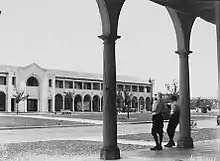
The Melbourne and Sydney buildings in Canberra's city centre, Civic, were based on design principles set by Sulman although the design work was finalised by J.H. Kirkpatrick. The buildings were the model which establish the colonnade principle, an important design element throughout Civic.
One of the most coveted architecture prizes, the prestigious Sir John Sulman Medal, also known as the Sulman Award, recognises excellence in public and commercial buildings. The medal is awarded by the New South Wales Chapter of the Royal Australian Institute of Architects. The medal was first awarded in 1932.
He was a trustee of the National Art Gallery of New South Wales from 1899 and its president from 1919.[4] The Sir John Sulman Prize for "the best subject/genre painting and/or murals/mural project executed during the two years preceding the [closing] date ..." has been held at the Art Gallery of New South Wales since 1936. It is hosted concurrently with the Archibald Prize, the most prominent Australian art prize, along with the Wynne prize and Dobell art prizes. The prize was established as a bequest by the Sulman family. When initiated the prize was about £100 annually and for the best subject painting or mural decoration by artists resident in Australia.
Sulman also endowed a lectureship in aeronautics at the University of Sydney in memory of his son Geoffrey who was killed during World War I while serving with the Flying Corps.
John Sulman's extensive collection of diaries, sketchbooks, correspondence, manuscripts, drawings and photographs was in the possession of family members for many years, but in 2018 it was lodged and catalogued in the State Library of New South Wales, Sydney. The papers reveal Sulman as a true polymath: architect, artist, author, educator, town planner, politician, historian, statesman, patriot, commentator, benefactor and polemicist.
Personal life
Sulman married Sarah Clark Redgate on 15 April 1875 at the Congregational Church at Caterham, Surrey. He had designed the church where they married, and theirs was the first wedding held there. They had three children, a son Arthur (1882–1971) and daughters Florence E. (1876–1965) and Edith (1877–1907)[5]
They moved to Sydney, Australia on account of his wife's tuberculosis. They arrived on 13 August 1885 and settled at Parramatta, where his wife died on 31 December 1888.[6]
His parents John (senior) and Martha moved into Addiscombe at Lane Cove Road, Turramurra.[7]
He married again, to Annie Elizabeth Masefield (a relative of John Masefield) at St Luke's Anglican Church, Burwood, on 27 April 1893.[8] His health broke down in 1896, prompting a trip to Europe. When they returned, he turned the cottage he had originally intended for his parents at Boomerang Street, Turramurra into their family home Ingleholme, which developed into a "rambling complex of gables, bays, turrets and chimneys".[9]
Children by this second marriage were Geoffrey, Dorothy Joan (b. 31 January 1896 d. 1971), and Thomas Noel ("Tom", or "Tommy"). Geoffrey enlisted in England and joined the Royal Flying Corps. He died aged 23 in 1917, in a flying accident over England, prior to being qualified for combat duties.[10] Thomas became a racing car driver, and developed the Sulman Singer, and Sulman Park in Bathurst is named after him. He was still racing in 1954. He died in 1970, aged 70.[11][12] Joan married Bruce Thomas Shallard, MD, and in 1947, moved to Vancouver, B.C. Canada, with their daughters, Barbara (Shallard) Ash, and Meryn (Shallard) Stranahan.
In 1913 John Sulman purchased the magnificent property "Kihilla" at Lawson in the Blue Mountains as a second home; it remained in the family until 1953.[13]
Mrs Sulman was socially active, being a prominent member of such organisations as the Leura and Lawson branches of the Red Cross Society. Florence, usually referred to as "Miss Sulman" was active in the Society of Arts and Crafts of NSW,[14] where she was president 1928–35 and 1951–56)[15] as well as hospital and kindergarten charities and the Women’s section of the NSW branch of the Town Planning Association.[16] Florence was author of the two-volume (1913, 1914) Wildflowers of New South Wales.[17]
Sulman retired in 1928[18] but remained a highly visible presence in civic, art and architectural circles, taking a prominent role in many public debates.[19] He died in Sydney aged 85 years.
Most of the family mentioned here are interred or memorialised at Gore Hill cemetery.[20]
Recognition
He was appointed Knight Bachelor in 1924.[21]
In 1926 he was elected to the International Housing and Town Planning Congress in Vienna.[22]
His portrait by John Longstaff won the Archibald Prize for 1931.
On 2 January 2008 it was announced that a suburb in the future Canberra district of Molonglo would be named Sulman.[23]
Gallery
St_Andrews_Presbyterian_Church-1.jpg.webp) St Andrew's Presbyterian Church, Manly
St Andrew's Presbyterian Church, Manly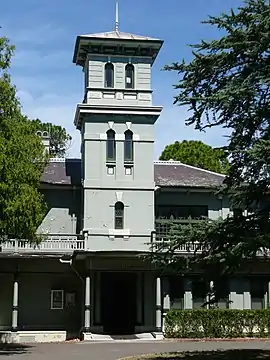 Yaralla Estate, Concord West (extended by Sulman 1893–99)
Yaralla Estate, Concord West (extended by Sulman 1893–99) Thomas Walker Convalescent Hospital, Concord West
Thomas Walker Convalescent Hospital, Concord West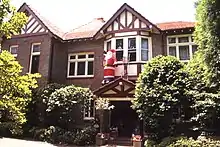 Ingleholme, Turramurra; Sulman's own home, designed by him in Federation Queen Anne style
Ingleholme, Turramurra; Sulman's own home, designed by him in Federation Queen Anne style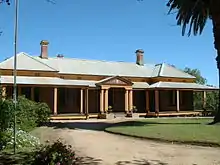 Bishop's Lodge, Hay, New South Wales, built in 1888–89, from corrugated iron
Bishop's Lodge, Hay, New South Wales, built in 1888–89, from corrugated iron Christ Church Anglican Church, Springwood, built in 1889
Christ Church Anglican Church, Springwood, built in 1889 The main building of The Armidale School designed by Sir John Sulman in 1892.
The main building of The Armidale School designed by Sir John Sulman in 1892.
References
- Goad, Willis (2012). Encyclopaedia of Australian Architecture. Cambridge University Press. pp. 665–666.
- "Thomas Walker Convalescent Hospital". NSW Office of Environment & Heritage - Search for Heritage. Retrieved 9 January 2019.
- An Ideal City – Timeline Archived 15 October 2005 at the Wayback Machine at www.idealcity.org.au
- Brisbane Courier 21 October 1926
- Apperly, Richard E.; Reynolds, Peter (1980). "Sulman, Sir John (1849–1934)". Australian Dictionary of Biography. National Centre of Biography, Australian National University. Retrieved 27 September 2018.
- "Family notices". The Sydney Morning Herald. 17 January 1889. Retrieved 27 September 2018 – via National Library of Australia.
- "Sir John Sulman - pictorial material". Manuscripts, Oral History, and Pictures Catalogue. State Library of New South Wales. Retrieved 27 September 2018.
- "Marriages". The Sydney Morning Herald. 15 May 1893. p. 8.
- http://www.sl.nsw.gov.au/discover_collections/people_places/north/architects/docs/north_shore_houses.pdf
- "Family notices". The Sydney Morning Herald. 23 June 1917 – via National Library of Australia.
- Sulman, Tom; Carment, David (2008). "The Flight of 'Waltzing Matilda'" (online). Journal of Northern Territory History (19): 82–89. ISSN 1034-7488. Retrieved 27 September 2018.
- Canberra Times Tuesday 5 October 1954
- http://www.midmountainshistory.org/kihilla.html
- Sydney Morning Herald 18 January 1930
- "Archived copy". Archived from the original on 12 July 2010. Retrieved 6 June 2010.CS1 maint: archived copy as title (link)
- Sydney Morning Herald 29 February 1928
- Brisbane Courier 12 January 1929
- The Argus obituary 20 August 1934
- Sydney Morning Herald 7 February 1931
- gravestone records
- The Argus 3 June 1924
- Brisbane Courier 30 September 1926
- "Suburbs named in new district". The Canberra Times. 3 January 2010. Archived from the original on 1 February 2011. Retrieved 21 September 2010.
- Serle, Percival (1949). "Sulman, John". Dictionary of Australian Biography. Sydney: Angus and Robertson.
Further reading
- Edwards, Zenaida The Life and Work of Sir John Sulman 1849–1934 PhD thesis for UTS 2006
- Edwards, Zeny A Life of Purpose: A Biography of John Sulman. Sydney: Longueville Media, 2017
- The Sulman Letters, Sydney University Archives, The Record, 1995
